Comprehensive Analysis of Share Buy-Back Procedures and Effects
VerifiedAdded on 2022/11/13
|6
|1932
|214
Report
AI Summary
This report provides a comprehensive analysis of share buybacks, exploring the accounting procedures, financial implications, and strategic considerations involved. It examines the process of share repurchase, including how companies buy back their own shares from the market and the motivations behind these actions, such as increasing earnings per share (EPS) and improving financial metrics like Return on Equity (ROE). The report details the effects of buybacks on financial statements, including the income statement, balance sheet, and cash flow, as well as the impact on investor portfolios and dividend policies. It also discusses the tax implications, legal considerations, and sources of funding for share buybacks, along with the importance of considering both short-term shareholder benefits and long-term growth priorities. The analysis includes various perspectives from academic research and real-world examples to provide a clear understanding of the complexities and benefits of share buybacks.
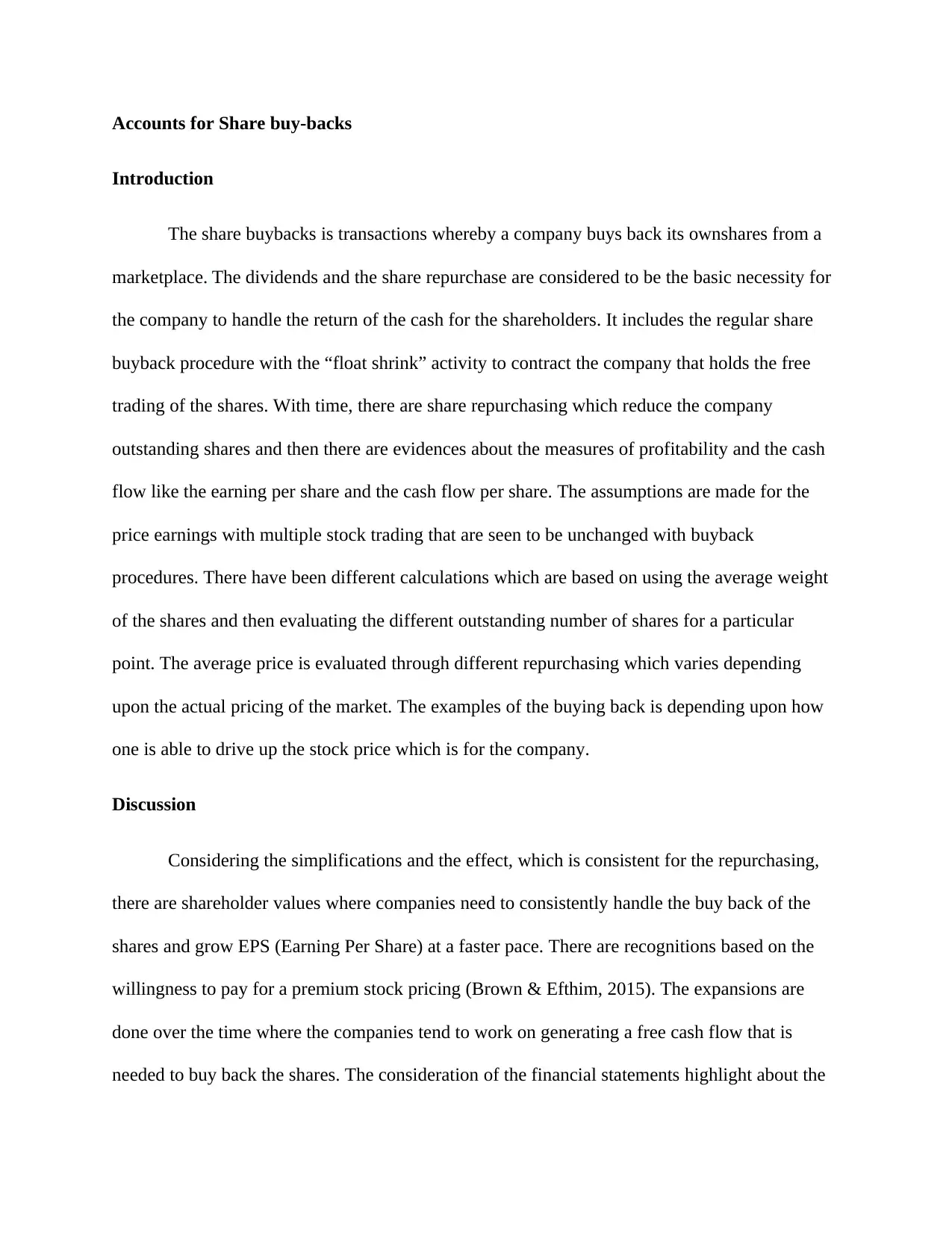
Accounts for Share buy-backs
Introduction
The share buybacks is transactions whereby a company buys back its ownshares from a
marketplace. The dividends and the share repurchase are considered to be the basic necessity for
the company to handle the return of the cash for the shareholders. It includes the regular share
buyback procedure with the “float shrink” activity to contract the company that holds the free
trading of the shares. With time, there are share repurchasing which reduce the company
outstanding shares and then there are evidences about the measures of profitability and the cash
flow like the earning per share and the cash flow per share. The assumptions are made for the
price earnings with multiple stock trading that are seen to be unchanged with buyback
procedures. There have been different calculations which are based on using the average weight
of the shares and then evaluating the different outstanding number of shares for a particular
point. The average price is evaluated through different repurchasing which varies depending
upon the actual pricing of the market. The examples of the buying back is depending upon how
one is able to drive up the stock price which is for the company.
Discussion
Considering the simplifications and the effect, which is consistent for the repurchasing,
there are shareholder values where companies need to consistently handle the buy back of the
shares and grow EPS (Earning Per Share) at a faster pace. There are recognitions based on the
willingness to pay for a premium stock pricing (Brown & Efthim, 2015). The expansions are
done over the time where the companies tend to work on generating a free cash flow that is
needed to buy back the shares. The consideration of the financial statements highlight about the
Introduction
The share buybacks is transactions whereby a company buys back its ownshares from a
marketplace. The dividends and the share repurchase are considered to be the basic necessity for
the company to handle the return of the cash for the shareholders. It includes the regular share
buyback procedure with the “float shrink” activity to contract the company that holds the free
trading of the shares. With time, there are share repurchasing which reduce the company
outstanding shares and then there are evidences about the measures of profitability and the cash
flow like the earning per share and the cash flow per share. The assumptions are made for the
price earnings with multiple stock trading that are seen to be unchanged with buyback
procedures. There have been different calculations which are based on using the average weight
of the shares and then evaluating the different outstanding number of shares for a particular
point. The average price is evaluated through different repurchasing which varies depending
upon the actual pricing of the market. The examples of the buying back is depending upon how
one is able to drive up the stock price which is for the company.
Discussion
Considering the simplifications and the effect, which is consistent for the repurchasing,
there are shareholder values where companies need to consistently handle the buy back of the
shares and grow EPS (Earning Per Share) at a faster pace. There are recognitions based on the
willingness to pay for a premium stock pricing (Brown & Efthim, 2015). The expansions are
done over the time where the companies tend to work on generating a free cash flow that is
needed to buy back the shares. The consideration of the financial statements highlight about the
Paraphrase This Document
Need a fresh take? Get an instant paraphrase of this document with our AI Paraphraser
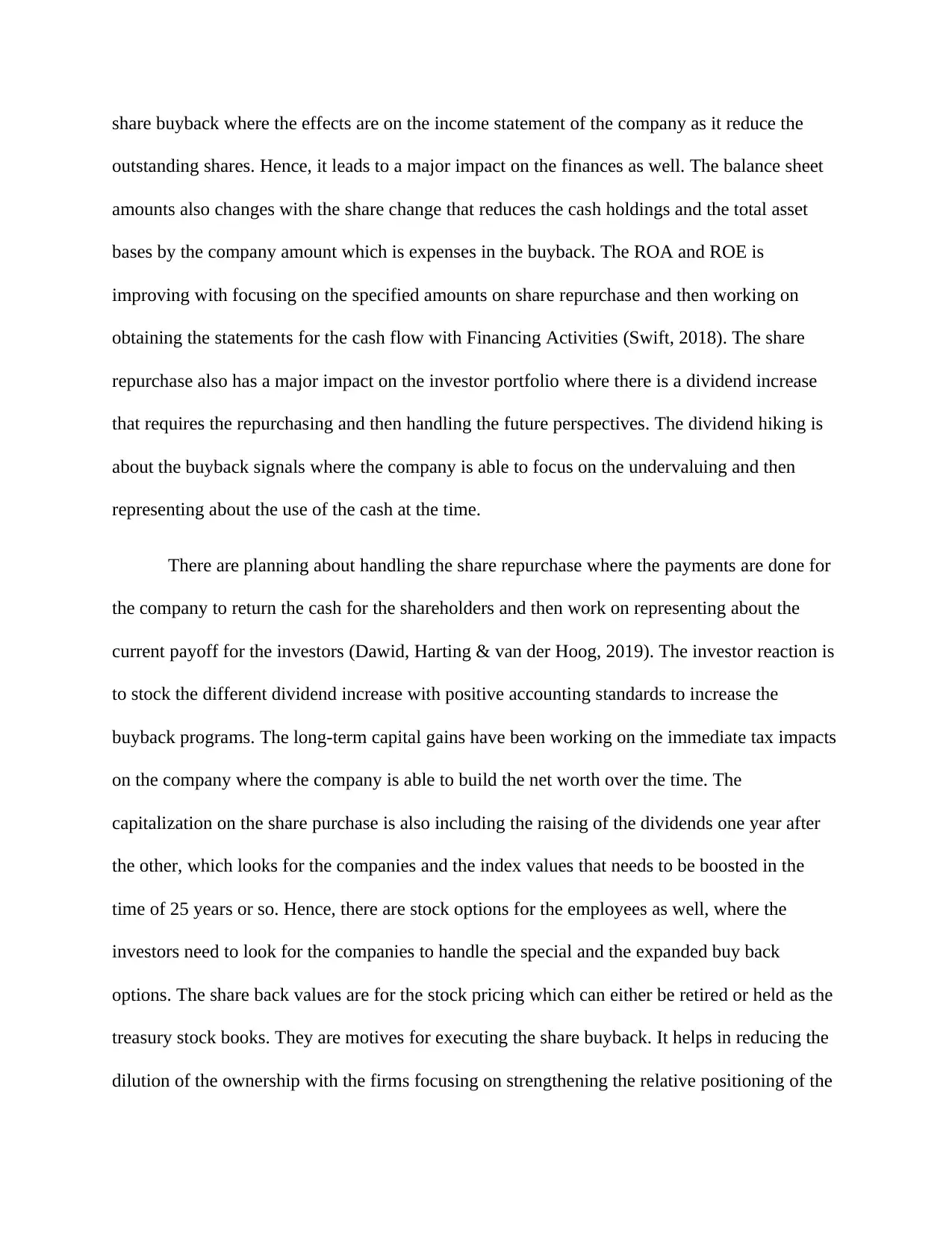
share buyback where the effects are on the income statement of the company as it reduce the
outstanding shares. Hence, it leads to a major impact on the finances as well. The balance sheet
amounts also changes with the share change that reduces the cash holdings and the total asset
bases by the company amount which is expenses in the buyback. The ROA and ROE is
improving with focusing on the specified amounts on share repurchase and then working on
obtaining the statements for the cash flow with Financing Activities (Swift, 2018). The share
repurchase also has a major impact on the investor portfolio where there is a dividend increase
that requires the repurchasing and then handling the future perspectives. The dividend hiking is
about the buyback signals where the company is able to focus on the undervaluing and then
representing about the use of the cash at the time.
There are planning about handling the share repurchase where the payments are done for
the company to return the cash for the shareholders and then work on representing about the
current payoff for the investors (Dawid, Harting & van der Hoog, 2019). The investor reaction is
to stock the different dividend increase with positive accounting standards to increase the
buyback programs. The long-term capital gains have been working on the immediate tax impacts
on the company where the company is able to build the net worth over the time. The
capitalization on the share purchase is also including the raising of the dividends one year after
the other, which looks for the companies and the index values that needs to be boosted in the
time of 25 years or so. Hence, there are stock options for the employees as well, where the
investors need to look for the companies to handle the special and the expanded buy back
options. The share back values are for the stock pricing which can either be retired or held as the
treasury stock books. They are motives for executing the share buyback. It helps in reducing the
dilution of the ownership with the firms focusing on strengthening the relative positioning of the
outstanding shares. Hence, it leads to a major impact on the finances as well. The balance sheet
amounts also changes with the share change that reduces the cash holdings and the total asset
bases by the company amount which is expenses in the buyback. The ROA and ROE is
improving with focusing on the specified amounts on share repurchase and then working on
obtaining the statements for the cash flow with Financing Activities (Swift, 2018). The share
repurchase also has a major impact on the investor portfolio where there is a dividend increase
that requires the repurchasing and then handling the future perspectives. The dividend hiking is
about the buyback signals where the company is able to focus on the undervaluing and then
representing about the use of the cash at the time.
There are planning about handling the share repurchase where the payments are done for
the company to return the cash for the shareholders and then work on representing about the
current payoff for the investors (Dawid, Harting & van der Hoog, 2019). The investor reaction is
to stock the different dividend increase with positive accounting standards to increase the
buyback programs. The long-term capital gains have been working on the immediate tax impacts
on the company where the company is able to build the net worth over the time. The
capitalization on the share purchase is also including the raising of the dividends one year after
the other, which looks for the companies and the index values that needs to be boosted in the
time of 25 years or so. Hence, there are stock options for the employees as well, where the
investors need to look for the companies to handle the special and the expanded buy back
options. The share back values are for the stock pricing which can either be retired or held as the
treasury stock books. They are motives for executing the share buyback. It helps in reducing the
dilution of the ownership with the firms focusing on strengthening the relative positioning of the
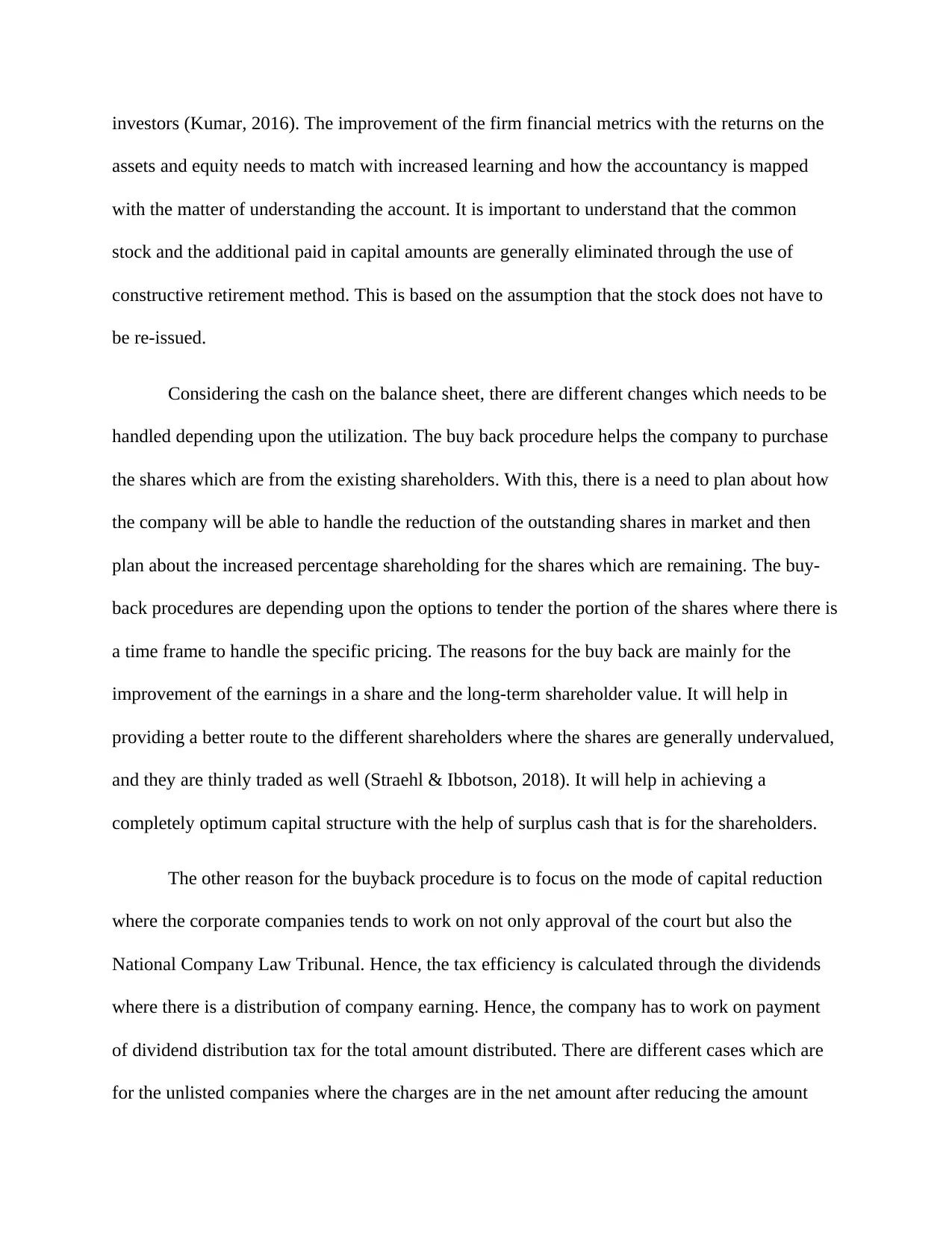
investors (Kumar, 2016). The improvement of the firm financial metrics with the returns on the
assets and equity needs to match with increased learning and how the accountancy is mapped
with the matter of understanding the account. It is important to understand that the common
stock and the additional paid in capital amounts are generally eliminated through the use of
constructive retirement method. This is based on the assumption that the stock does not have to
be re-issued.
Considering the cash on the balance sheet, there are different changes which needs to be
handled depending upon the utilization. The buy back procedure helps the company to purchase
the shares which are from the existing shareholders. With this, there is a need to plan about how
the company will be able to handle the reduction of the outstanding shares in market and then
plan about the increased percentage shareholding for the shares which are remaining. The buy-
back procedures are depending upon the options to tender the portion of the shares where there is
a time frame to handle the specific pricing. The reasons for the buy back are mainly for the
improvement of the earnings in a share and the long-term shareholder value. It will help in
providing a better route to the different shareholders where the shares are generally undervalued,
and they are thinly traded as well (Straehl & Ibbotson, 2018). It will help in achieving a
completely optimum capital structure with the help of surplus cash that is for the shareholders.
The other reason for the buyback procedure is to focus on the mode of capital reduction
where the corporate companies tends to work on not only approval of the court but also the
National Company Law Tribunal. Hence, the tax efficiency is calculated through the dividends
where there is a distribution of company earning. Hence, the company has to work on payment
of dividend distribution tax for the total amount distributed. There are different cases which are
for the unlisted companies where the charges are in the net amount after reducing the amount
assets and equity needs to match with increased learning and how the accountancy is mapped
with the matter of understanding the account. It is important to understand that the common
stock and the additional paid in capital amounts are generally eliminated through the use of
constructive retirement method. This is based on the assumption that the stock does not have to
be re-issued.
Considering the cash on the balance sheet, there are different changes which needs to be
handled depending upon the utilization. The buy back procedure helps the company to purchase
the shares which are from the existing shareholders. With this, there is a need to plan about how
the company will be able to handle the reduction of the outstanding shares in market and then
plan about the increased percentage shareholding for the shares which are remaining. The buy-
back procedures are depending upon the options to tender the portion of the shares where there is
a time frame to handle the specific pricing. The reasons for the buy back are mainly for the
improvement of the earnings in a share and the long-term shareholder value. It will help in
providing a better route to the different shareholders where the shares are generally undervalued,
and they are thinly traded as well (Straehl & Ibbotson, 2018). It will help in achieving a
completely optimum capital structure with the help of surplus cash that is for the shareholders.
The other reason for the buyback procedure is to focus on the mode of capital reduction
where the corporate companies tends to work on not only approval of the court but also the
National Company Law Tribunal. Hence, the tax efficiency is calculated through the dividends
where there is a distribution of company earning. Hence, the company has to work on payment
of dividend distribution tax for the total amount distributed. There are different cases which are
for the unlisted companies where the charges are in the net amount after reducing the amount
⊘ This is a preview!⊘
Do you want full access?
Subscribe today to unlock all pages.

Trusted by 1+ million students worldwide
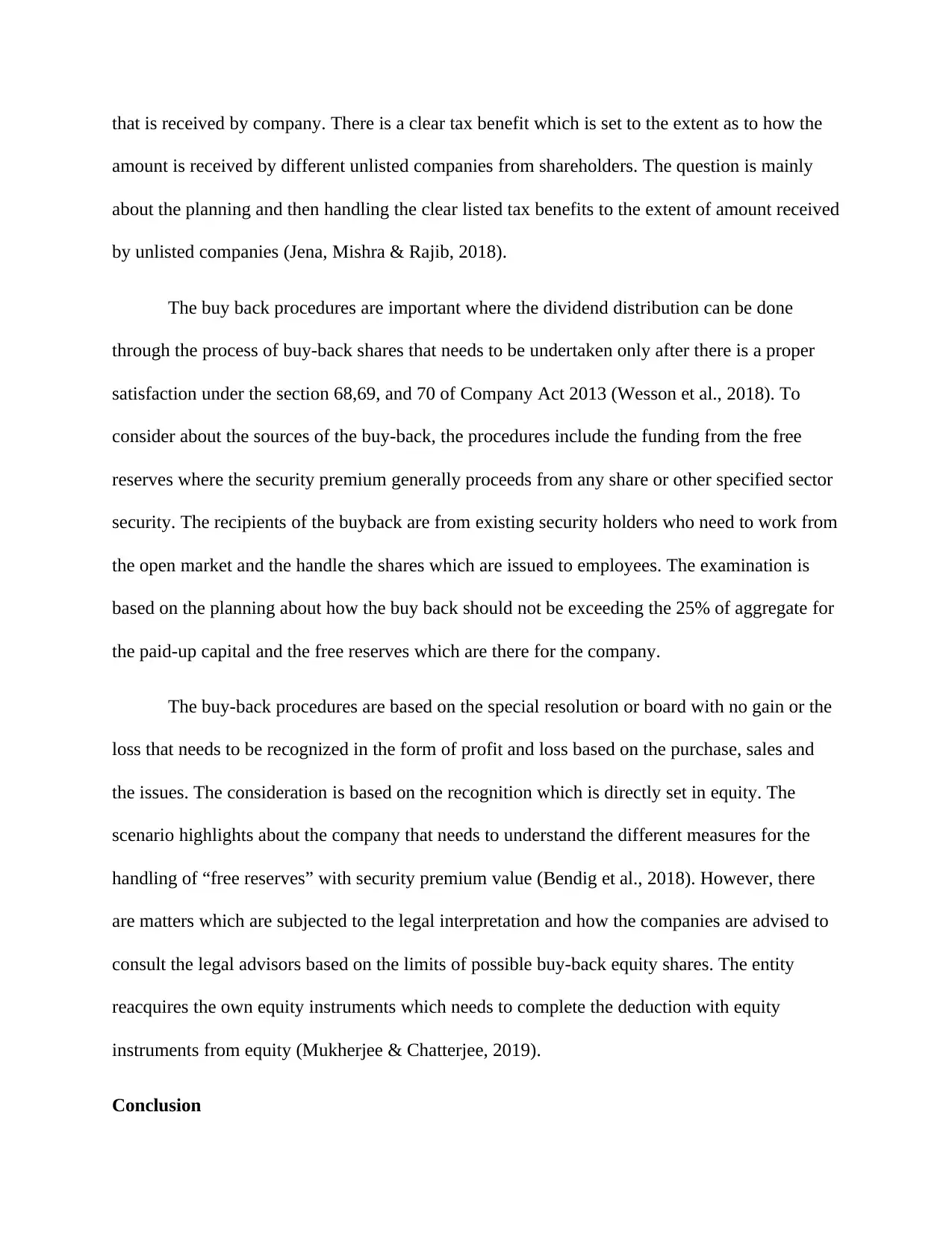
that is received by company. There is a clear tax benefit which is set to the extent as to how the
amount is received by different unlisted companies from shareholders. The question is mainly
about the planning and then handling the clear listed tax benefits to the extent of amount received
by unlisted companies (Jena, Mishra & Rajib, 2018).
The buy back procedures are important where the dividend distribution can be done
through the process of buy-back shares that needs to be undertaken only after there is a proper
satisfaction under the section 68,69, and 70 of Company Act 2013 (Wesson et al., 2018). To
consider about the sources of the buy-back, the procedures include the funding from the free
reserves where the security premium generally proceeds from any share or other specified sector
security. The recipients of the buyback are from existing security holders who need to work from
the open market and the handle the shares which are issued to employees. The examination is
based on the planning about how the buy back should not be exceeding the 25% of aggregate for
the paid-up capital and the free reserves which are there for the company.
The buy-back procedures are based on the special resolution or board with no gain or the
loss that needs to be recognized in the form of profit and loss based on the purchase, sales and
the issues. The consideration is based on the recognition which is directly set in equity. The
scenario highlights about the company that needs to understand the different measures for the
handling of “free reserves” with security premium value (Bendig et al., 2018). However, there
are matters which are subjected to the legal interpretation and how the companies are advised to
consult the legal advisors based on the limits of possible buy-back equity shares. The entity
reacquires the own equity instruments which needs to complete the deduction with equity
instruments from equity (Mukherjee & Chatterjee, 2019).
Conclusion
amount is received by different unlisted companies from shareholders. The question is mainly
about the planning and then handling the clear listed tax benefits to the extent of amount received
by unlisted companies (Jena, Mishra & Rajib, 2018).
The buy back procedures are important where the dividend distribution can be done
through the process of buy-back shares that needs to be undertaken only after there is a proper
satisfaction under the section 68,69, and 70 of Company Act 2013 (Wesson et al., 2018). To
consider about the sources of the buy-back, the procedures include the funding from the free
reserves where the security premium generally proceeds from any share or other specified sector
security. The recipients of the buyback are from existing security holders who need to work from
the open market and the handle the shares which are issued to employees. The examination is
based on the planning about how the buy back should not be exceeding the 25% of aggregate for
the paid-up capital and the free reserves which are there for the company.
The buy-back procedures are based on the special resolution or board with no gain or the
loss that needs to be recognized in the form of profit and loss based on the purchase, sales and
the issues. The consideration is based on the recognition which is directly set in equity. The
scenario highlights about the company that needs to understand the different measures for the
handling of “free reserves” with security premium value (Bendig et al., 2018). However, there
are matters which are subjected to the legal interpretation and how the companies are advised to
consult the legal advisors based on the limits of possible buy-back equity shares. The entity
reacquires the own equity instruments which needs to complete the deduction with equity
instruments from equity (Mukherjee & Chatterjee, 2019).
Conclusion
Paraphrase This Document
Need a fresh take? Get an instant paraphrase of this document with our AI Paraphraser
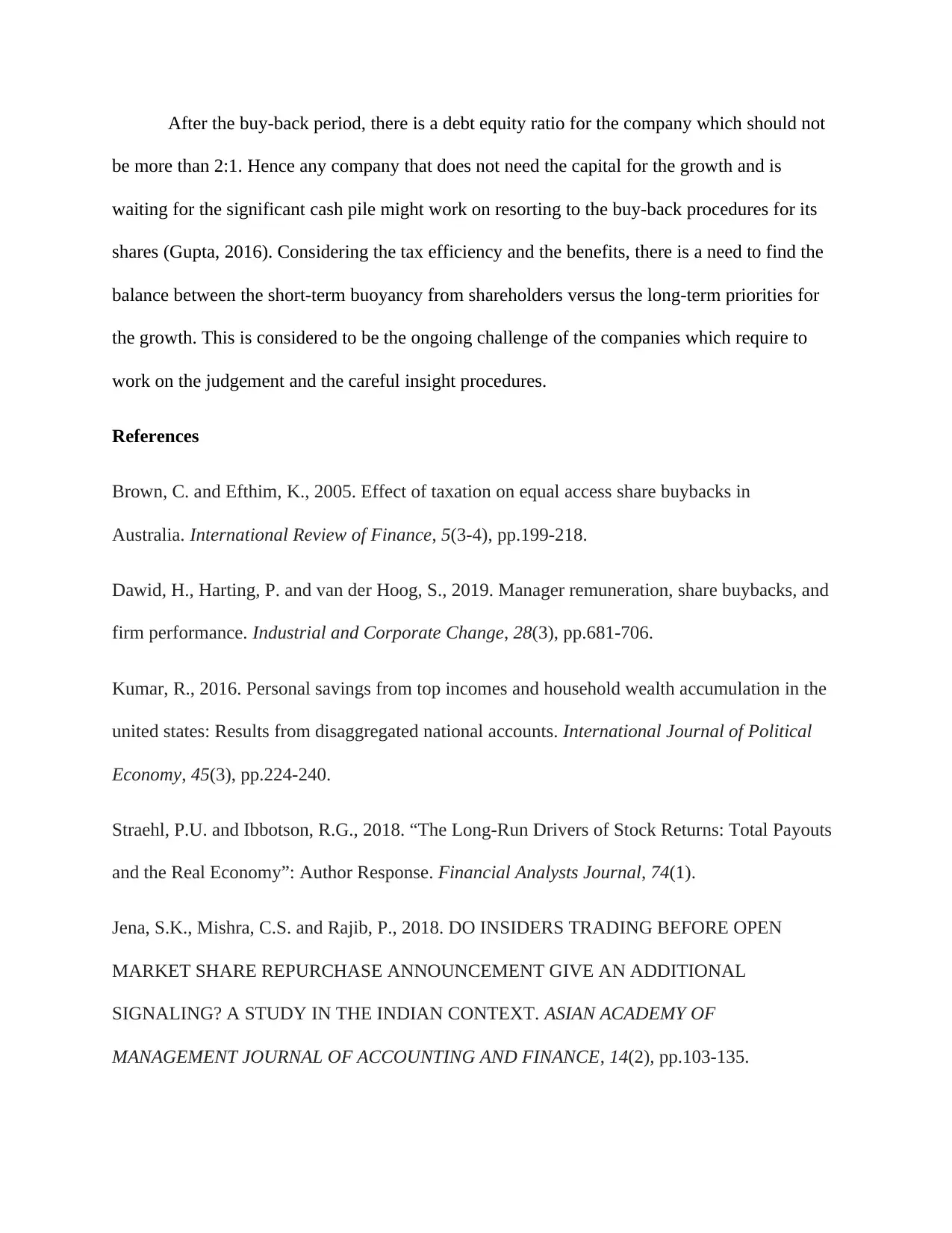
After the buy-back period, there is a debt equity ratio for the company which should not
be more than 2:1. Hence any company that does not need the capital for the growth and is
waiting for the significant cash pile might work on resorting to the buy-back procedures for its
shares (Gupta, 2016). Considering the tax efficiency and the benefits, there is a need to find the
balance between the short-term buoyancy from shareholders versus the long-term priorities for
the growth. This is considered to be the ongoing challenge of the companies which require to
work on the judgement and the careful insight procedures.
References
Brown, C. and Efthim, K., 2005. Effect of taxation on equal access share buybacks in
Australia. International Review of Finance, 5(3‐4), pp.199-218.
Dawid, H., Harting, P. and van der Hoog, S., 2019. Manager remuneration, share buybacks, and
firm performance. Industrial and Corporate Change, 28(3), pp.681-706.
Kumar, R., 2016. Personal savings from top incomes and household wealth accumulation in the
united states: Results from disaggregated national accounts. International Journal of Political
Economy, 45(3), pp.224-240.
Straehl, P.U. and Ibbotson, R.G., 2018. “The Long-Run Drivers of Stock Returns: Total Payouts
and the Real Economy”: Author Response. Financial Analysts Journal, 74(1).
Jena, S.K., Mishra, C.S. and Rajib, P., 2018. DO INSIDERS TRADING BEFORE OPEN
MARKET SHARE REPURCHASE ANNOUNCEMENT GIVE AN ADDITIONAL
SIGNALING? A STUDY IN THE INDIAN CONTEXT. ASIAN ACADEMY OF
MANAGEMENT JOURNAL OF ACCOUNTING AND FINANCE, 14(2), pp.103-135.
be more than 2:1. Hence any company that does not need the capital for the growth and is
waiting for the significant cash pile might work on resorting to the buy-back procedures for its
shares (Gupta, 2016). Considering the tax efficiency and the benefits, there is a need to find the
balance between the short-term buoyancy from shareholders versus the long-term priorities for
the growth. This is considered to be the ongoing challenge of the companies which require to
work on the judgement and the careful insight procedures.
References
Brown, C. and Efthim, K., 2005. Effect of taxation on equal access share buybacks in
Australia. International Review of Finance, 5(3‐4), pp.199-218.
Dawid, H., Harting, P. and van der Hoog, S., 2019. Manager remuneration, share buybacks, and
firm performance. Industrial and Corporate Change, 28(3), pp.681-706.
Kumar, R., 2016. Personal savings from top incomes and household wealth accumulation in the
united states: Results from disaggregated national accounts. International Journal of Political
Economy, 45(3), pp.224-240.
Straehl, P.U. and Ibbotson, R.G., 2018. “The Long-Run Drivers of Stock Returns: Total Payouts
and the Real Economy”: Author Response. Financial Analysts Journal, 74(1).
Jena, S.K., Mishra, C.S. and Rajib, P., 2018. DO INSIDERS TRADING BEFORE OPEN
MARKET SHARE REPURCHASE ANNOUNCEMENT GIVE AN ADDITIONAL
SIGNALING? A STUDY IN THE INDIAN CONTEXT. ASIAN ACADEMY OF
MANAGEMENT JOURNAL OF ACCOUNTING AND FINANCE, 14(2), pp.103-135.
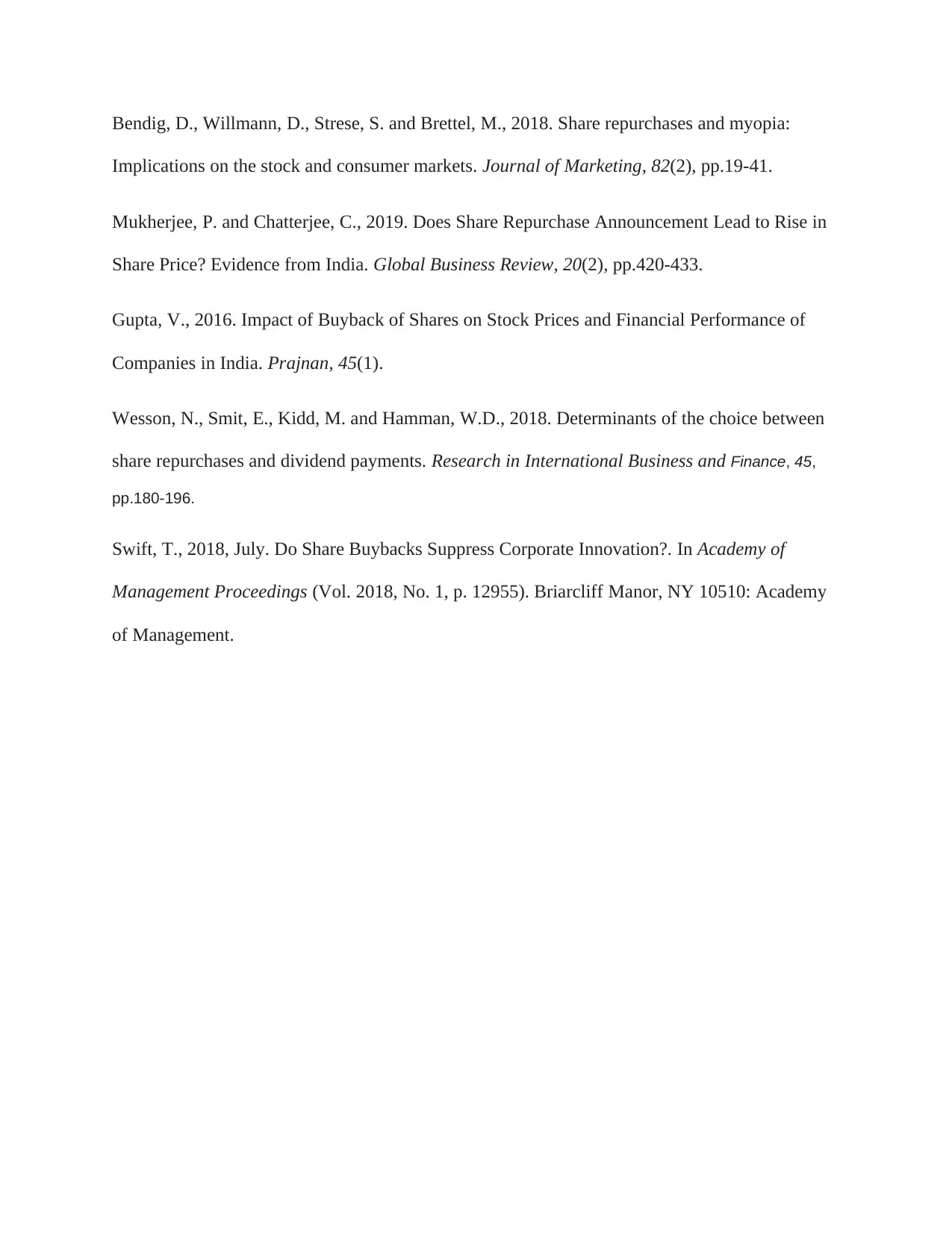
Bendig, D., Willmann, D., Strese, S. and Brettel, M., 2018. Share repurchases and myopia:
Implications on the stock and consumer markets. Journal of Marketing, 82(2), pp.19-41.
Mukherjee, P. and Chatterjee, C., 2019. Does Share Repurchase Announcement Lead to Rise in
Share Price? Evidence from India. Global Business Review, 20(2), pp.420-433.
Gupta, V., 2016. Impact of Buyback of Shares on Stock Prices and Financial Performance of
Companies in India. Prajnan, 45(1).
Wesson, N., Smit, E., Kidd, M. and Hamman, W.D., 2018. Determinants of the choice between
share repurchases and dividend payments. Research in International Business and Finance, 45,
pp.180-196.
Swift, T., 2018, July. Do Share Buybacks Suppress Corporate Innovation?. In Academy of
Management Proceedings (Vol. 2018, No. 1, p. 12955). Briarcliff Manor, NY 10510: Academy
of Management.
Implications on the stock and consumer markets. Journal of Marketing, 82(2), pp.19-41.
Mukherjee, P. and Chatterjee, C., 2019. Does Share Repurchase Announcement Lead to Rise in
Share Price? Evidence from India. Global Business Review, 20(2), pp.420-433.
Gupta, V., 2016. Impact of Buyback of Shares on Stock Prices and Financial Performance of
Companies in India. Prajnan, 45(1).
Wesson, N., Smit, E., Kidd, M. and Hamman, W.D., 2018. Determinants of the choice between
share repurchases and dividend payments. Research in International Business and Finance, 45,
pp.180-196.
Swift, T., 2018, July. Do Share Buybacks Suppress Corporate Innovation?. In Academy of
Management Proceedings (Vol. 2018, No. 1, p. 12955). Briarcliff Manor, NY 10510: Academy
of Management.
⊘ This is a preview!⊘
Do you want full access?
Subscribe today to unlock all pages.

Trusted by 1+ million students worldwide
1 out of 6
Related Documents
Your All-in-One AI-Powered Toolkit for Academic Success.
+13062052269
info@desklib.com
Available 24*7 on WhatsApp / Email
![[object Object]](/_next/static/media/star-bottom.7253800d.svg)
Unlock your academic potential
Copyright © 2020–2025 A2Z Services. All Rights Reserved. Developed and managed by ZUCOL.





